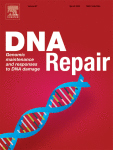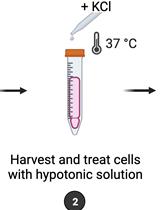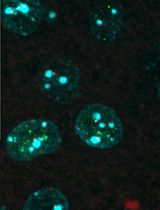- EN - English
- CN - 中文
Real-time Base Excision Repair Assay to Measure the Activity of the 8-oxoguanine DNA Glycosylase 1 in Isolated Mitochondria of Human Skin Fibroblasts
实时碱基切除修复法测定人皮肤纤维细胞的分离线粒体中8-氧鸟嘌呤DNA糖基化酶1的活性
(*contributed equally to this work) 发布: 2021年03月20日第11卷第6期 DOI: 10.21769/BioProtoc.3954 浏览次数: 4409
评审: Michael T VelingAnonymous reviewer(s)
Abstract
7,8-dihydro-8-oxoguanine (8-oxoG) is one of the most common and mutagenic oxidative DNA damages induced by reactive oxygen species (ROS). Since ROS is mainly produced in the inner membranes of the mitochondria, these organelles and especially the mitochondrial DNA (mtDNA) contained therein are particularly affected by this damage. Insufficient elimination of 8-oxoG can lead to mutations and thus to severe mitochondrial dysfunctions. To eliminate 8-oxoG, the human body uses the enzyme 8-oxoguanine DNA glycosylase 1 (OGG1), which is the main antagonist to oxidative damage to DNA. However, previous work suggests that the activity of the human OGG1 (hOGG1) decreases with age, leading to an age-related accumulation of 8-oxoG. A better understanding of the exact mechanisms of hOGG1 could lead to the discovery of new targets and thus be of great importance for the development of preventive therapies. Because of this, we developed a real-time base excision repair assay with a specially designed double-stranded reporter oligonucleotides to measure the activity of hOGG1 in lysates of isolated mitochondria. This system presented here differs from the classical assays, in which an endpoint determination is performed via a denaturing acrylamide gel, by the possibility to measure the hOGG1 activity in real-time. In addition, to determine the activity of each enzymatic step (N-glycosylase and AP-lyase activity) of this bifunctional enzyme, a melting curve analysis can also be performed. After isolation of mitochondria from human fibroblasts using various centrifugation steps, they are lysed and then incubated with specially designed reporter oligonucleotides. The subsequent measurement of hOGG1 activity is performed in a conventional real-time PCR system.
Keywords: DNA repair (DNA修复)Background
The human body represents a permanent case of damage. Each of the approximately 1013 body cells suffers tens of thousands to about 100,000 damages to its DNA per day (Janion, 2001; Jackson and Bartek, 2009). 7,8-dihydro-8-oxoguanine (8-oxoG) is one of the most common oxidative DNA damages induced by reactive oxygen species (ROS). By oxidizing the base guanine to 7,8-dihydro-8-oxoguanine, 8-oxoG, in contrast to guanine, is now able to hybridize not only with cytosine but also with adenine. This can lead to a complete base exchange after the second replication and thus trigger serious mutations. The replacement of a guanine/cytosine base pair by thymine/adenine is one of the most frequent mutations in human cancer. This so-called transversion also occurs frequently in the tumor suppressor gene p53 (Hirano, 2008). For this reason, and based on the fact that between 1,000 and 2,000 8-oxoG lesions per day occur in a healthy cell, while in tumor cells the number of 8-oxoG lesions increases up to 1,000,000, 8-oxoG is considered to be one of the major causes of cancer (Ravanat et al., 2000; Nakabeppu, 2014). Furthermore, 8-oxoG is associated with aging processes and degenerative diseases (such as Alzheimer's disease and Parkinson's disease) (Sampath et al., 2012; Nakabeppu, 2014) and thus shows great pathophysiological relevance.
To counteract these processes, the human body uses the enzyme 8-oxoguanine DNA glycosylase 1 (OGG1), which is the main antagonist to oxidative damage to DNA. Before replication, it removes 8-oxoG by means of base excision repair (BER), replaces it with a guanine base and thus prevents the development of mutations (Radicella et al., 1997; Hamann et al., 2009). However, previous studies indicate that the activities of glycosylases and thus also the activity of the human OGG1 (hOGG1) decrease with increasing age (Loft and Poulsen, 1996; Gorbunova et al., 2007). This has the effect on an organism that sooner or later, as a result of the reduced hOGG1 activity and the resulting decrease in the ability to perform BER processes, an age-related accumulation of 8-oxoG occurs. A better understanding of the exact mechanisms of hOGG1 could lead to the discovery of new targets and thus be of great importance for the development of preventive therapies.
For the measurement of the hOGG1 activity we developed an assay that exploits the principle of enzymatic removal of 8-oxoG from DNA as well as the cut into its sugar-phosphate backbone by hOGG1 as a part of the BER. The principle of the enzymatic removal of 8-oxoG from DNA as well as the incision in its sugar-phosphate backbone by hOGG1 during a BER is used. Lysates from isolated mitochondria are incubated with specially designed reporter oligonucleotides for this assay. Each of the two double-stranded constructs consists of 33 nucleotides and identical sequence. In addition, both carry a 6-carboxyfluorescein (6-FAM) molecule at each end of the reporter strand and a black hole quencher (BHQ) at each end of the complementary strand (Figure 1). Thus, in each double-stranded construct, the 6-FAM molecule (fluorescent dye) is opposite of BHQ which suppresses the fluorescence of the dye. The DNA glycosylase present in the lysates from the mitochondria recognizes the damage to the reporter oligonucleotide (CN-8-oxoG) and first cuts out the oxidized base, followed by a cut in the phosphate backbone. The incised DNA strand then dissociates from the counter strand at the incubation temperature of 37 °C and a fluorescence signal can be measured. The strength of the signal correlates with the repair activity or AP lyase activity of the hOGG1 enzyme. The use of an undamaged reporter oligonucleotide (CN-CTRL) serves as a control to exclude unspecific digestion of the oligonucleotides (Figure 2A). To determine the resulting oligonucleotide fragments, a melting curve analysis is performed at a temperature of 95 °C to 20 °C after completion of the real-time activity measurement. For this purpose, the first derivation of the trend of the fluorescence signal as a function of temperature is recorded (-(d/dT)). The resulting minima represent the melting temperatures of the different fragments (Figure 2B).
Materials and Reagents
2-Mercaptoethanol (Carl Roth, catalog number: 4227.1 )
Benzamidine (Carl Roth, catalog number: CN38.1 )
BHQ (single-stranded) ([BHQ1]GGTATTATTATTATTGCGTTATTATTATTATGG[BHQ1] 100 μM) (Sigma-Aldrich)
Bovine serum albumin (BSA) (New England BioLabs®, catalog number: B9000S )
Cell culture flasks T25, T75, T175 (Sarstedt, catalog numbers: 83.3910.302 , 83.3911.302 , 833912.302 )
CHAPS (Carl Roth, catalog number: 1479.1 )
CN-8-oxoG (single-stranded) ([6FAM]CCATAATAATAATAAC[8-oxo-dG]CAATAATAATAATA
CC[6FAM] 100 µM) (Sigma-Aldrich)
CN-CTRL (single-stranded) ([6FAM]CCATAATAATAATAACGCAATAATAATAATACC[6FAM] 100 µM) (Sigma-Aldrich)
cOmpleteTM Mini Protease Inhibitor Cocktail (Roche Diagnostics, catalog number: 04693124001 )
DMSO (Carl Roth, catalog number: A994.2 )
Dulbecco’s Modified Eagle’s Medium–high glucose (Sigma-Aldrich, catalog number: D7777-10L )
EGTA (Carl Roth, catalog number: 3054.1 )
Fetal bovine serum (FBS) (Gibco®, catalog number: 26140079 )
Gentamycin (10 mg/ml) (Gibco®, catalog number: 11500506 )
Glycerol (Carl Roth, catalog number: 6967.1 )
Injection cannula (G 20 × 1½”) (B. Braun, catalog number: 4657519 )
KCl (Carl Roth, catalog number: 6781.3 )
KH2PO4 (Carl Roth, catalog number: 3904.2 )
LightCycler® 480 Multiwell Plate 96 (white) (Roche Diagnostics, catalog number: 04729692001 )
LightCycler® 480 Sealing Foil (Roche Diagnostics, catalog number: 04729757001 )
MgCl2 (Carl Roth, catalog number: KK36.1 )
Na2HPO4·12H2O (Carl Roth, catalog number: N350.1 )
NaCl (Carl Roth, catalog number: 3957.3 )
NEBufferTM2 (New England BioLabs®, catalog number: B7002S )
Pipette filter tips: 2.5 µl, 10 µl, 20 µl, 200 µl, 1,000 µl (Sarstedt, catalog numbers: 70.1130.217 , 70.1130.215 , 70.1114.215 , 70.760.216 , 70.762.216 )
QuinoMit®–carrier control (MSE Pharmazeutika)
QuinoMit® Q10-Fluid–ubiquinol (MSE Pharmazeutika)
Reaction Tubes: 0.2 ml, 1.5 ml (Sarstedt, catalog numbers: 72.737.002 , 72.706.201 )
Recombinant Human OGG1 protein (100 µg) (Abcam, catalog number: ab98249 )
Syringe 2 ml (Injekt® 2 ml) (B. Braun, catalog number: 4606027V )
Tris-HCl (Carl Roth, catalog number: 9090.3 )
Tri-sodium citrate dihydrate (≥99%) (Carl Roth, catalog number: 3580.4 )
Trypsin-EDTA (0.5%) (Gibco®, catalog number: 10779413 )
1× PBS (see Recipes)
CHAPS buffer (see Recipes)
Carrier control (10 mM) (see Recipes)
Ubiquinol formulation (10 mM) (see Recipes)
DMEM for Fibroblasts (see Recipes)
Reaction buffer (see Recipes)
2 M tri-sodium citrate dihydrate (see Recipes)
Equipment
Centrifuge Eppendorf 5427 R (Eppendorf, catalog number: 5409000210 )
Centrifuge Eppendorf 5804 R (Eppendorf, catalog number: 5805000010 )
Freezer (Liebherr Comfort (Liebherr, catalog number: not available)
Incubator at 37 °C with 5% CO2, 90% humidity (HERA Cell 240, catalog number: 2510-413-01 )
LightCycler® 480 (Roche Diagnostics, catalog number: 05015278001 )
PCR-Cooler (Eppendorf, catalog number: 3881000031 )
pH Meter FiveEasyTM F20 (Mettler Toledo, catalog number: 30266626 )
Pipettes, Eppendorf Research® Plus: 0.1 µl 10 µl, 20 µl, 200 µl, 1,000 µl (Eppendorf, catalog numbers: 3123000012 , 3123000020 , 3123000039 , 3123000055 , 3123000063 )
Sonoplus Ultraschall-Homogenisator HD 3100 (Bandelin Electronic)
Thermocycler MKR13 HLC (DITABIS, catalog number: MKR 13 )
Ultrapure water (ddH2O) preparation unit, Purelab flex 4 (Veolia Water Technologies)
Software
GraphPad Prism, Version 8.2.1 (GraphPad Software®)
LightCycler® 480 Software (instrument software), Version 1.5.0.39 (Roche Diagnostics)
Procedure
文章信息
版权信息
© 2021 The Authors; exclusive licensee Bio-protocol LLC.
如何引用
Schniertshauer, D., Gebhard, D. and Bergemann, J. (2021). Real-time Base Excision Repair Assay to Measure the Activity of the 8-oxoguanine DNA Glycosylase 1 in Isolated Mitochondria of Human Skin Fibroblasts. Bio-protocol 11(6): e3954. DOI: 10.21769/BioProtoc.3954.
分类
分子生物学 > DNA > DNA 损伤和修复
细胞生物学 > 基于细胞的分析方法
您对这篇实验方法有问题吗?
在此处发布您的问题,我们将邀请本文作者来回答。同时,我们会将您的问题发布到Bio-protocol Exchange,以便寻求社区成员的帮助。
Share
Bluesky
X
Copy link













